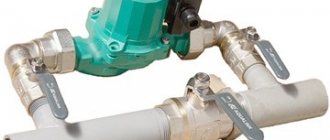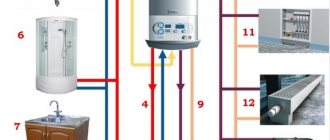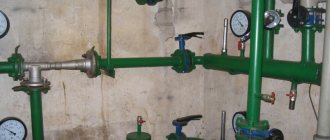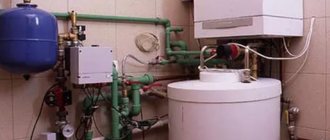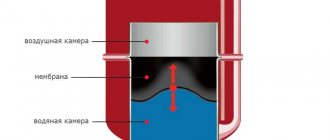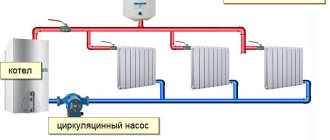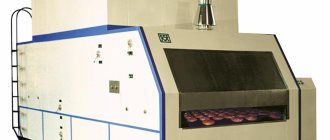What is an open chamber gas boiler?
Gas boilers of this type, also called natural draft devices, operate by using atmospheric air as a source of oxygen for combustion. It is thus taken from the room where the boiler is installed in the required quantity due to natural draft, which is formed due to the movement of air from the premises to the outside.
Gas boiler with open chamber
Combustion products in devices of this type are discharged through a special chimney: its presence in the boiler design is mandatory. This may somewhat complicate the installation of the unit in residential premises: there must be good ventilation there, otherwise the operation of the boiler due to the active use of air can negatively affect the health of people in the rooms.
It is therefore recommended to install gas boilers in special rooms located in those parts of the building that are located at a sufficient distance from living rooms. These premises must comply with established safety standards. Chimneys are also installed in them.
Open chamber boilers are quite easy to maintain. They are relatively inexpensive. An alternative to them may be units with a closed combustion chamber. Let's study their features.
Which boiler is better with an open or closed combustion chamber - there is an answer
Today, to heat your home, you can choose any option from hundreds of models on the market. However, many do not understand which boiler is better - with an open or closed combustion chamber. Although the models may be almost the same in appearance, dimensions and level of thermal power. Small subtleties based on different operating principles may cause inconvenience in the future. And sometimes it creates quite big problems.
Atmospheric burner or open combustion method
A boiler with an open combustion chamber is the simplest device possible. Essentially, this is a large gas burner, above which there is a coil of thin tubes for coolant. Fuel combustion is carried out in the presence of atmospheric air.
To ensure a continuous flow of oxygen into the core, any device, be it a single-circuit wall-mounted gas boiler with an open combustion chamber or a floor-standing high-capacity model, is equipped with channels for air intake from the outside.
Typically the boiler takes air from the room. However, there are models that require wall mounting and air intake from outside, for which an additional hole for the air duct is made in the wall. The advantages of such a scheme are obvious.
- The time-tested technology is reliable, the solutions have been tested many times, so the price on the market is minimal when compared with other types of units.
- The noise during operation of the boiler is minimal, since the only source of sound is the flame, which burns almost silently.
- The design uses a minimum of parts subject to wear. Therefore, periodic maintenance comes down to checking the ignition.
If we describe such a boiler in a few phrases, it will sound something like this: an inexpensive device, almost silent, does not require periodic maintenance; repairs consist of cleaning the coil tubes from scale, as well as cleaning the burner nozzles. But there are features inherent in boilers with an atmospheric burner:
- Since the device consumes oxygen, it is necessary either to organize a separate boiler room or to ensure good ventilation of the room where the boiler is located. Sometimes it’s forced. This is a danger of drafts and other inconveniences.
- A chimney is required. If a boiler with an open combustion system is installed in a multi-storey building, responsible organizations will definitely require that the “exhaust pipe” be taken out beyond the roof ridge. The chimney is vital to ensure good draft.
- Compared to other devices, atmospheric heaters are the most uneconomical in terms of fuel consumption.
As can be seen from the disadvantages of such a heating unit, its use will be preferable in a country house, if it is necessary to heat a large area, when it is convenient to use a heat accumulator as part of the piping, and all equipment will be located in a separate boiler room with a good chimney.
Blast burner or turbocharged boilers
Gas boilers of one of the latest generations are switching to forced air injection into the active combustion zone. The design of the heating block has changed. Now this is a closed chamber in which there is a gas nozzle and an air supply channel from an external fan. The walls of the block are double, water passes between them. When gas burns, it heats up, and waste (smoke) is released under the pressure of the supercharger through the chimney.
This design is more productive, since the gas is burned almost completely. The smoke is less toxic compared to atmospheric burners, and the efficiency is higher, since the area of contact of water with the walls of the chamber increases. Eliminates the need for a chimney. The use of air pressure during supply creates the necessary draft, and combustion products are ejected over a sufficiently large distance. Short chimneys, horizontally located, are widely used to remove smoke outside the room.
Air enters from outside along the same path where combustion products are discharged. The chimney pipe is double. This allows the air taken in from outside to be heated using the heat of the exhaust gases. The advantages of boilers with a closed combustion chamber look something like this:
- lower fuel consumption compared to atmospheric burners;
- during normal operation of the turbine, draft and stable operation of the boiler are guaranteed;
- no chimney is required, can be installed in apartment buildings - smoke is emitted at a distance of almost 3 meters from the wall;
- there is no need to organize a separate boiler room or provide ventilation - the gas mixture is prepared with the participation of outside air. You can choose ventilation and air conditioning systems, for example multi-split systems, at akmeklimat.ru.
But, like any complex device, units with injection units have disadvantages.
- Periodic maintenance is required, including checking the turbine, lubrication, and cleaning the blades.
- Like any device with moving parts, a turbine has a finite lifespan.
- There is a danger of freezing in the combustion area. Due to the short chimney, into which air penetrates during strong outside winds, this can lead to an accident in good frost. Modern boiler models are equipped with automatic valves and a temperature control system - this adds complexity and does not have the best effect on reliability.
- The boiler is quite noisy due to the operation of the turbine. Over time, due to wear of the bushings and contamination of the blades, the noise increases.
- Despite the fact that fuel is saved, quite a lot of electricity is consumed, which is necessary for the turbine and electronic control systems.
If we compare the economic efficiency of a “clean” device without additional piping, the indicators of atmospheric and turbocharged boilers are equal. Fuel savings are spent on paying for electricity and replacing failing moving parts of a boiler with a closed firebox.
Comparison of market models
To evaluate these indicators in numbers, let’s take two arbitrary models of boilers of the same class from a popular manufacturer and compare.
| Model | VAILLANT atmoTec VUW 240-5 | VAILLANT turboTec VUW 282-3 |
| Installation | wall | wall |
| Camera | Open, chimney | Closed, supercharger |
| power, kWt | 24 | 28 |
| Contours | 2 | 2 |
| Control and regulation | Electronic control | Electronic control |
| The amount of nitrogen oxide in exhaust gases | 145 mg/kWh | 135 mg/kWh |
| Dimensions, cm | 80x44x33.8 | 80x44x33.8 |
| Weight | 35 | 40 |
| Price, USD | 1050 | 1075 |
As you can see, there are almost no differences in dimensions, weight, price, and other indicators. A turbocharged boiler shows the expected advantage in heat transfer and lower exhaust toxicity.
Up
Since there is no big difference in economic efficiency and the cost of the device itself between forced and atmospheric combustion boilers, the choice should be made based on side factors. The possibility of organizing a boiler room, ventilation, the risk of freezing, the need to install a chimney, and the presence of noise should be taken into account.
What is a closed chamber gas boiler?
This type of boiler also uses atmospheric air to burn gas. However, the combustion products of the units in question are discharged not through a traditional chimney, but through a coaxial one. This is possible thanks to the activation of the horizontal smoke removal function. A coaxial chimney is easier to install than a traditional one. Air is taken from the atmosphere by a special fan, and the action of natural draft is not used.
Gas boiler with closed chamber
The advantage of boilers of this type is that, unlike units with an open system, they do not have to be installed in special rooms; if necessary, they can be installed in residential ones. True, the rooms must have sufficient area, since a gas boiler is a very large unit.
The main design element of the fan, which removes the smoke generated in the boiler, is the electric motor. Therefore, in the room in which the gas boiler is installed, there must also be a free outlet.
Features of a closed combustion chamber
A closed combustion chamber is a closed area with a burner, where air is pumped through a coaxial chimney, which is a pipe in a pipe, and combustion products are removed. Forced air circulation is ensured through the use of an electric fan, which makes the heating system dependent on the availability of electricity and also increases the noise level in the room.
The forced air is heated by the exhaust gases, which promotes complete combustion of the fuel . This, in turn, increases the efficiency of boilers with a closed chamber and improves their environmental safety. Boilers with a closed chamber are easy to install, they do not require bulky chimneys, and they are perfect for organizing autonomous heating in apartments.
Disadvantages include regular maintenance, significant energy consumption and the danger of freezing in the combustion area due to the short length of the coaxial chimney. The fuel savings provided by boilers with a closed chamber are usually offset by the costs of electricity, maintenance and the purchase of spare parts needed in case of repairs.
Repair and constructionComment
Comparison
The main difference between an open chamber and a closed chamber in gas boilers is that the first element of the unit’s design operates due to natural draft and involves the removal of gas combustion products through a traditional chimney installed in a special room. Preferably located at a distance from living rooms.
The second type of chamber in gas boilers involves directing air from the atmosphere into the unit using a fan, and also provides for the removal of the resulting smoke. As a result, combustion products can be removed through a coaxial chimney. It has a less complex design, as a result of which the boiler of this type can be installed in residential premises.
Having determined what the difference is between an open and a closed chamber in gas boilers, we will reflect the conclusions in a small table.
Design features and operating principle
To understand that the failure is a single-circuit gas boiler with an open combustion chamber , you need to imagine an open flame source above which a heat exchanger is installed. The operating principle of this unit is simple: the thermal energy generated by burning gas heats the walls of the heat exchanger through which running water circulates. In other words, the simplest gas boiler is a flow-through heater designed to create and maintain the required temperature of the coolant circulating in the heating system.
The combustion chamber
The vast majority of domestic consumers usually find it difficult to determine what an open combustion chamber of a gas boiler means ? We will try to answer this question as clearly as possible.
As you know, oxygen is needed to maintain the combustion process. Air supply to the heat generator can be forced or natural. In installations with an open combustion chamber, draft is created in the chimney, and the air mixture is taken directly from the room in which the boiler unit is installed. All exhaust gases are discharged into the atmosphere through the chimney.
You should know! Draft, without the use of blowing devices, appears due to the difference in the density of hot and cold air. Combustion products have a high temperature and, therefore, lower density than the surrounding air. Based on this, the pressure of the gas column in the chimney will also be less than in the room. The pressure difference creates draft: the air from the room pushes out lighter exhaust gases and itself participates in the process of fuel combustion.
Heat exchanger
A single-circuit gas boiler with an open combustion chamber is equipped with one heat exchanger, which can be made of:
- Of stainless steel. This material has good durability. The disadvantages are low thermal conductivity and high cost. Boilers with such a heat exchanger have a fairly low efficiency.
- Galvanized steel. The most inexpensive and short-lived type of coil.
- Copper. Good thermal conductivity at relatively low cost. Boilers with a copper heat exchanger have high efficiency, which makes them the most economical in terms of fuel consumption.
In double-circuit gas boilers with an open combustion chamber, two types of heat exchangers are used:
- Modular. Structurally, this heat exchanger consists of two modules: the primary one, made in the form of a finned coil, heats the coolant for the heating system; the secondary one, made in the form of a set of plates, is responsible for creating the domestic hot water supply at home.
You should know! Despite the fact that such a heat exchanger is considered one part, the modules are located in different places of the heat generator. The primary one is installed above the burner, the secondary one is installed at the bottom of the gas boiler.
- Bithermic. Structurally, this type of heat exchanger is designed like a pipe within a pipe. In the cavity, between the walls of the outer and inner tubes, a coolant circulates, which heats the water for hot water circulating through the inner tube of the coil.
Table
| Open chamber in a gas boiler | Closed chamber in a gas boiler |
| Functions by using natural traction | Does not involve the use of natural draft, since air from the atmosphere is directed into the boiler using a fan |
| Involves the removal of gas combustion products through a traditional chimney | It involves the removal of gas combustion products, reduced in volume by removing the resulting smoke, through a coaxial chimney |
| A boiler with an open chamber must be installed in a special room - where it is possible to install a traditional chimney; in many cases, it is desirable to locate it away from the living rooms | A boiler with a closed chamber can be installed in a residential area (but provided that it is possible to connect a fan, which directs air into the chamber and dissipates smoke in the unit, to an outlet) |
Disadvantages of devices
Due to the need for constant draft, drafts occur. In addition, its strength depends on weather conditions (temperature, wind). The operation of the hood in the kitchen also affects the draft. There are other disadvantages too.
Expensive installation
Boilers with an open chamber are dangerous to install in residential premises.
For them, it is advisable to equip a separate boiler room , the size of which depends on the power of the device. The combustion chamber is thought through at the design stage of the house.
It must have windows . You will also need a reliable system for forced ventilation of the room. This significantly increases the overall installation costs.
Important! Wall-mounted models of gas boilers are also allowed to be installed in the kitchen if its volume is more than 7.5 m 3 and the ceilings are higher than 2 meters. A window with an area of at least 0.6 m2 is required.
Sometimes, to increase reliability sensors are added to gas boilers that monitor undesirable phenomena that interfere with operation (for example, weakening of draft). If necessary, the boiler automatically turns off. Such a system also requires additional costs.
Presence of a vertical chimney
A vertical chimney is necessary to remove exhaust gases. It has certain requirements:
- The cross-section of the pipe is not less than the diameter of the smoke exhaust pipe.
- The height to the first turn is at least 0.5 meters and two pipe diameters.
- A certain height of the pipe above the roof.
Photo 3. Wall-mounted gas boiler with an open combustion chamber. It is equipped with a chimney made of steel pipes.
It is determined by its location on the roof:
- no more than 1.5 meters from the ridge or on a flat roof - 0.5 m;
- from 1.5 to 3 meters to the ridge - not lower than its height;
- further than 3 meters from the ridge - not lower than a conventional line drawn from the ridge at an angle of 10° to the horizon.
Attention! The material used is steel or special polymer materials . A brick pipe will not work. It will quickly collapse under the influence of condensation.
Arranging a suitable chimney for a gas boiler is quite difficult . In addition, it is associated with certain material costs.
Open combustion chamber
The open combustion chamber is based on natural draft, that is, the combustion air is taken from the room where the boiler is installed.
And the exhaust gases go up the chimney naturally. Therefore, this type of boiler requires ventilation of the room in which they are located. The downside is that when installing a boiler in residential premises, and in case of insufficiently good ventilation, there may be a lack of oxygen, a feeling of stuffiness and even cases of carbon monoxide poisoning. Therefore, it is recommended to allocate a separate small room for such equipment - the furnace room, which must meet all the necessary requirements of your heating equipment, be suitable in size and be equipped in accordance with the necessary safety standards. Such a furnace must be equipped with a vertical chimney and ventilation (providing 3-fold air exchange).
There are also advantages: the cost of gas boilers with an open chamber is low noise, an order of magnitude cheaper, and, in addition, among such boilers there are boilers that do not depend on the availability of electricity.
